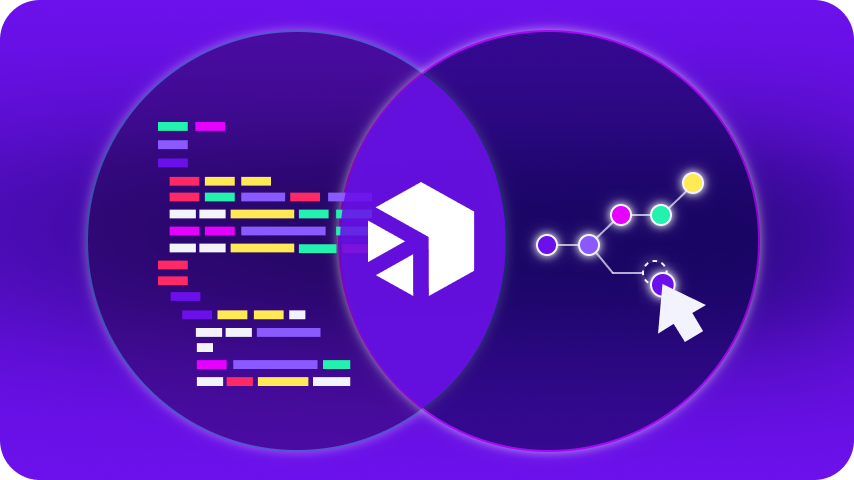April 4, 2023
A lot of buzz words get bandied about in business meetings, and especially around tech topics it can be hard to a) keep up and b) keep it straight. So if you are feeling a little self-conscious about having to google what these terms really mean, just know that the problem isn’t you.
Any technology term is relatively young and the meaning will naturally shift or be refined over time. Both the practices of researching terms and independently asking the person you are working with to define how they use terms are integral for meaningful communication between the business and technology sides of any company.
In this blog post we will explore several common terms relating to digital commerce infrastructure:
- Monolithic Commerce
- Headless Commerce
- Composable Commerce
What is Monolithic Architecture?
A traditional monolithic architecture essentially packages every part of an application into one large computing network. In today’s cloud-centric and platform as a service world, this notion sounds a bit archaic. In its defense, monolithic architecture is not an entirely ancient relic; it still provides an easy solution that continues to work for many companies, and there are many “out of the box” options available.
“Monolithic” derives from the Ancient Greek word μονόλιθος (monólithos), from μόνος (mónos) meaning “one” or “single” and λίθος (líthos) meaning “stone”. While we’re confident that even the most change-resistant IT person isn’t running your website on anything made of stone, it is a great visual for the concepts that underpin monolithic architecture in technology.
The main difficulty that arises for those with a monolithic system is adaptability. Making a change to a monolithic system is about as impossible as trying to dig something out of the bottom of a large suitcase while keeping your clothes folded. Updating or even just maintaining a monolithic system can put pressure on your personnel, who have to constantly dig through legacy code to keep the system running.
What is Headless Commerce?
Headless commerce architecture is built in a way where the back-end or server-side logic has been decoupled from the front end user interface. In this architecture type, the back-end system connects to your user interface through APIs that are typically RESTful APIs that expose data in a standardized way, allowing them to be consumed by a variety of different clients and used for a variety of business use cases. Monolithic architecture also uses APIs, but by contrast they are built to be tightly coupled with that system’s back-end, and are designed to execute very specific business use cases.
What are the advantages of headless architectures? When building a front end interface with headless, developers are able to maintain a higher level of freedom to create customized user experiences without having to be concerned about the intricacies of the back-end. Headless back-end systems can also be used simultaneously by multiple client applications, so a website, a mobile app, a kiosk and a chatbot can all share the same underlying system without causing issues between them. Ultimately, this promises more flexibility as the retail technology landscape continues to evolve, and ensures better visibility and connectedness of data sources as retailers attempt to execute on the omnichannel experience for customers and prospective customers alike.
What is Composable Commerce?
Composable commerce architecture emphasizes the use of interchangeable and independent components – or microservices. These services can include everything from inventory management and product searches, to shopping carts and payment vendors. By breaking down a solution into these discrete and independent services, a business can easily swap out or re-work a service without major risk to the system as a whole.
This modularity lends an enormous amount of flexibility to a business, and allows it to adapt quicker than their monolithic competitors to new technologies as they become available. Like headless commerce, these modules are typically linked through RESTful APIs that expose data from one microservice to another.
“In turbulent times, composable business principles help organizations master the accelerated change that is essential for business resilience and growth. Without it, modern organizations risk losing their market momentum and customer loyalty.”
David Groombridge, Research Vice President, Gartner
This high level of flexibility does come with some additional considerations for the team. Unlike monolithic “out of the box” solution options, a composable commerce site is bespoke, and requires developers to build. Managing numerous microservices and APIs can also be challenging, and a comprehensive approach for how to connect and monitor them needs to not only be implemented, but kept up to date with each change to the system.
Composable Commerce vs Headless
There really is no “vs” when it comes to composable commerce and headless commerce, they have a substantial amount of overlap as they both rely on RESTful APIs to link different parts of their respective systems together.
Is headless commerce always composable?
Whether headless commerce is composable is essentially reliant on whether its APIs and services are designed in a way that is truly modular and reusable. If a website has been built with the back and front end decoupled but the APIs are built to specifically work only for that system’s back-end then it can be considered headless, but not composable.
Is composable commerce always headless?
The short answer is no, because technically there is no requirement for a composable architecture to even have a front-end interface, but the longer answer is that they often are as a headless front-end can provide the modularity needed to support composable commerce.
Why is an Integration company like Digibee writing about this anyways?
The conversations about innovation for most digital commerce companies today need to encompass their approach to technology architecture as a whole, but also be able to zoom in and understand how each piece of that system would fit together to meet the business needs.
With so much important data being generated, whatever approach to your system architecture you adopt needs to be able to capture that data in a way that adds value to your business. This is where e-commerce integration comes in.
Digibee has been built to fully support many approaches to technical architecture. Whether you are working with a fully composable commerce system, or just starting the journey of migrating away from your monolithic e-commerce, we can help. Our low-code eiPaaS scales quickly and easily to integrate all your independent services thanks to our reusable Digibee capsules, giving you full flexibility to make the most of your system data.
If you’re interested in how Digibee can help your organization evolve to a modular IT environment, we’d be happy to show you how. Book your choice of a 15-minute discovery call, 30-minute custom demo, or a 60-minute deep dive to learn more.













